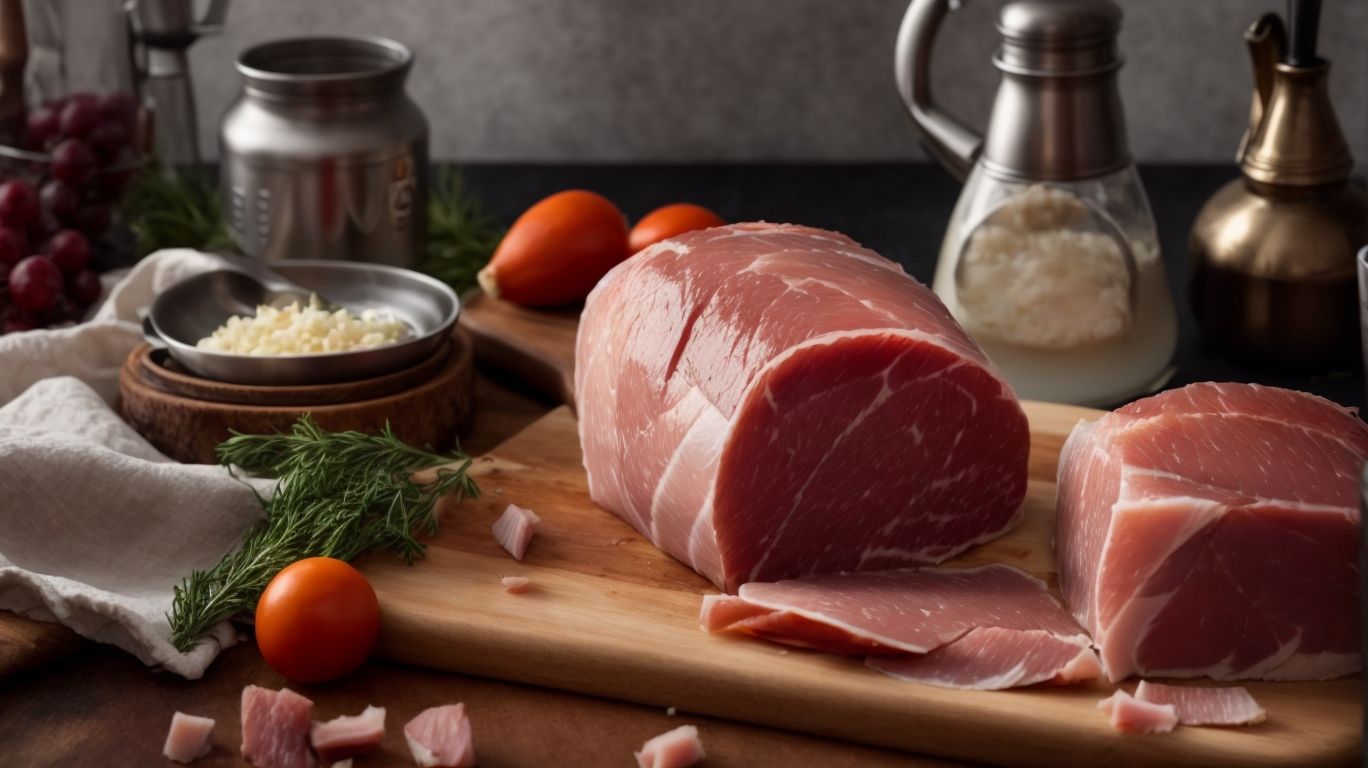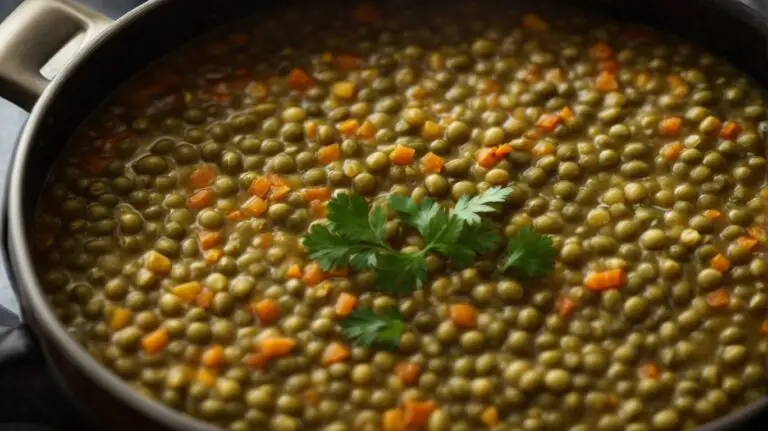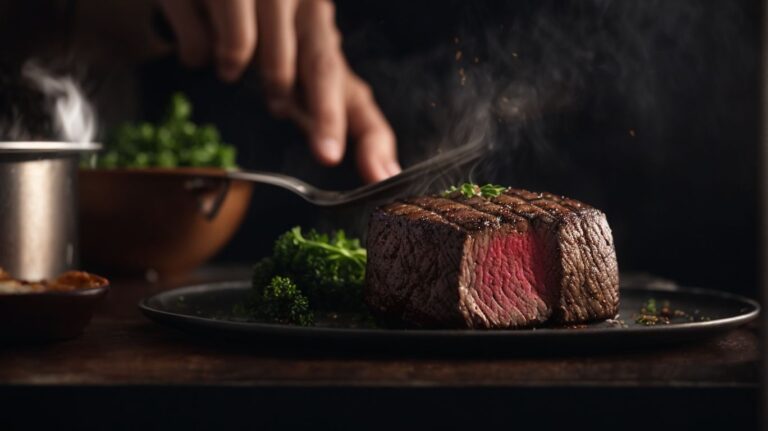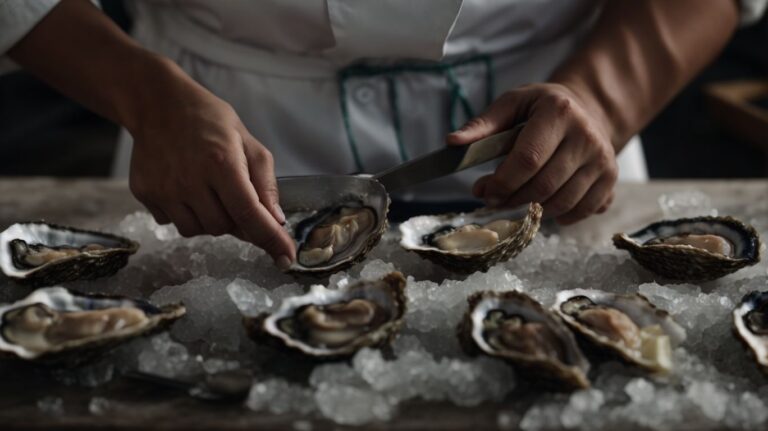How to Cook a Netted Ham?
Looking to impress your dinner guests with a delicious and perfectly cooked ham? This comprehensive guide on how to cook a netted ham covers everything from selecting the best ingredients to the recommended cooking time and temperature. Join Chris Poormet as he shares expertise on preparing, cooking, serving, and storing a mouth-watering netted ham. Let’s get cooking!
Key Takeaways:
What is a Netted Ham?
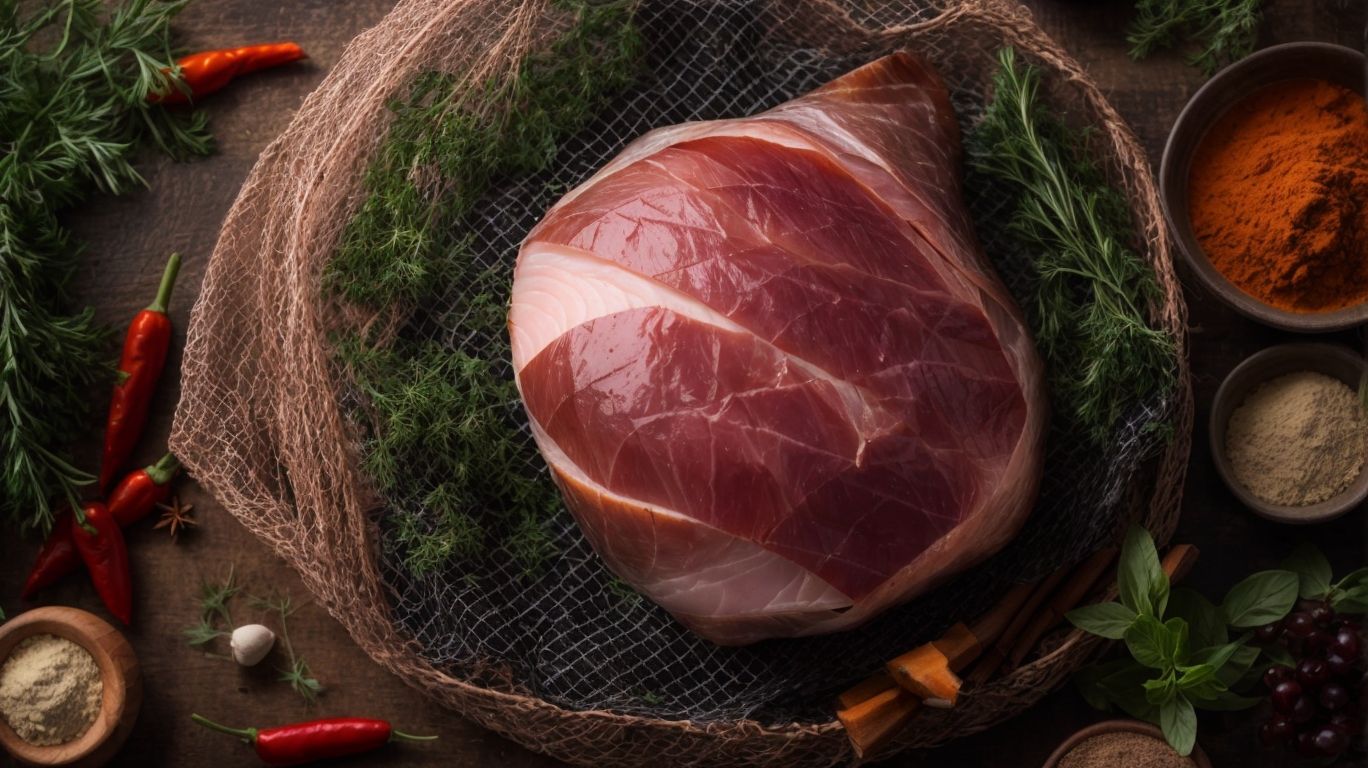
Credits: Poormet.Com – Brandon Roberts
A netted ham is a type of ham that is wrapped in a netting material for cooking and packaging purposes.
Netted hams are usually boneless hams that are encased in a tight netting to help them maintain their shape during cooking. The netting also serves to hold any added glazes or seasonings in place, ensuring that the flavors infuse the ham evenly. This method of packaging not only enhances the presentation of the ham but also makes carving and serving much easier.
In terms of cooking, the netting material helps the ham cook more evenly by holding it together throughout the process. This results in a ham that is juicy, tender, and full of flavor. The netting can be easily removed after cooking, allowing for a beautiful and intact presentation.
The benefits of using a netting material for hams go beyond just aesthetics. The netting helps to keep the ham in a uniform shape, preventing it from spreading out while cooking. It also facilitates the application of glazes, which can caramelize and add a delicious crust to the ham. The netting simplifies the process of transferring the ham to serving platters without any loss of shape or moisture.
How is a Netted Ham Different from Other Hams?
A netted ham differs from other hams in its packaging and cooking method, offering convenience and uniform shape during the cooking process.
One of the standout benefits of a netted ham is the way it retains its shape and moisture due to the netting encasing the meat, ensuring that each slice is juicy and succulent. Flavor infusion is also enhanced as the netting helps to trap the juices and seasonings within the ham as it cooks, resulting in a more intense and delicious taste. In terms of cooking, the netting provides an easy way to score the ham for glazing, as the lines created by the netting not only add visual appeal but also allow the flavors to penetrate the meat evenly. When it’s time to carve the ham, the netting serves as a guide for clean and uniform slices, perfect for elegant serving presentations. Netted hams truly offer a hassle-free and impressive way to elevate your ham experience.”
What Ingredients Do You Need to Cook a Netted Ham?

Credits: Poormet.Com – Andrew Thomas
To cook a netted ham, you need a variety of ingredients such as ham, glaze, and seasonings to enhance the flavor profile of the dish.
In terms of glazes for your ham, options like a sweet brown sugar glaze or a tangy mustard sauce can add a delightful contrast to the savory ham. Cloves are a classic spice that pairs beautifully with ham, providing a warm and aromatic flavor. Seasonings like black pepper, garlic powder, and a touch of paprika can further elevate the taste profile of the dish. Consider incorporating fruits like pineapple rings or cherries for a burst of sweetness that complements the rich flavors of the ham.
What Type of Ham is Best for Cooking?
In terms of cooking a ham, choosing the right type is crucial for achieving optimal flavor and texture in the final dish.
One of the key decisions to make is whether to opt for bone-in or boneless ham. Bone-in hams, typically known for their richer flavor and juiciness, are often preferred by those seeking a more traditional taste. On the other hand, boneless hams are easier to carve and serve, making them convenient for those looking for simplicity.
Another factor to consider is whether to go for spiral-cut hams or whole hams. Spiral-cut hams are pre-sliced, allowing for easy serving and uniform cooking. Conversely, whole hams provide the flexibility to customize the slicing thickness according to preferences.
The quality of the ham itself plays a crucial role in the cooking process. Opting for a high-quality ham sourced from reputable producers can significantly enhance the overall flavor and tenderness of the final dish. Whether you choose bone-in or boneless, spiral-cut or whole, selecting a premium quality ham will undoubtedly elevate your culinary experience.
What Other Ingredients Can Be Used for Flavouring?
Plus the ham itself, various ingredients can be used to add depth and richness to the flavor profile of the dish, making it a delightful choice for entertaining guests.
One of the popular ways to enhance the flavor of ham is by incorporating a honey glaze. The sweet and sticky glaze not only caramelizes beautifully on the surface of the ham when baked but also adds a pleasant contrast to the savory notes.
Another option is to opt for a pineapple marinade which infuses the ham with tropical undertones. The acidity from the pineapple helps to cut through the richness of the meat, creating a harmonious balance of flavors.
For a more complex and robust taste, consider using maple syrup as a glaze. The deep, earthy sweetness of maple syrup can elevate the ham to a gourmet level, impressing even the most discerning palates.
What Tools Do You Need to Cook a Netted Ham?
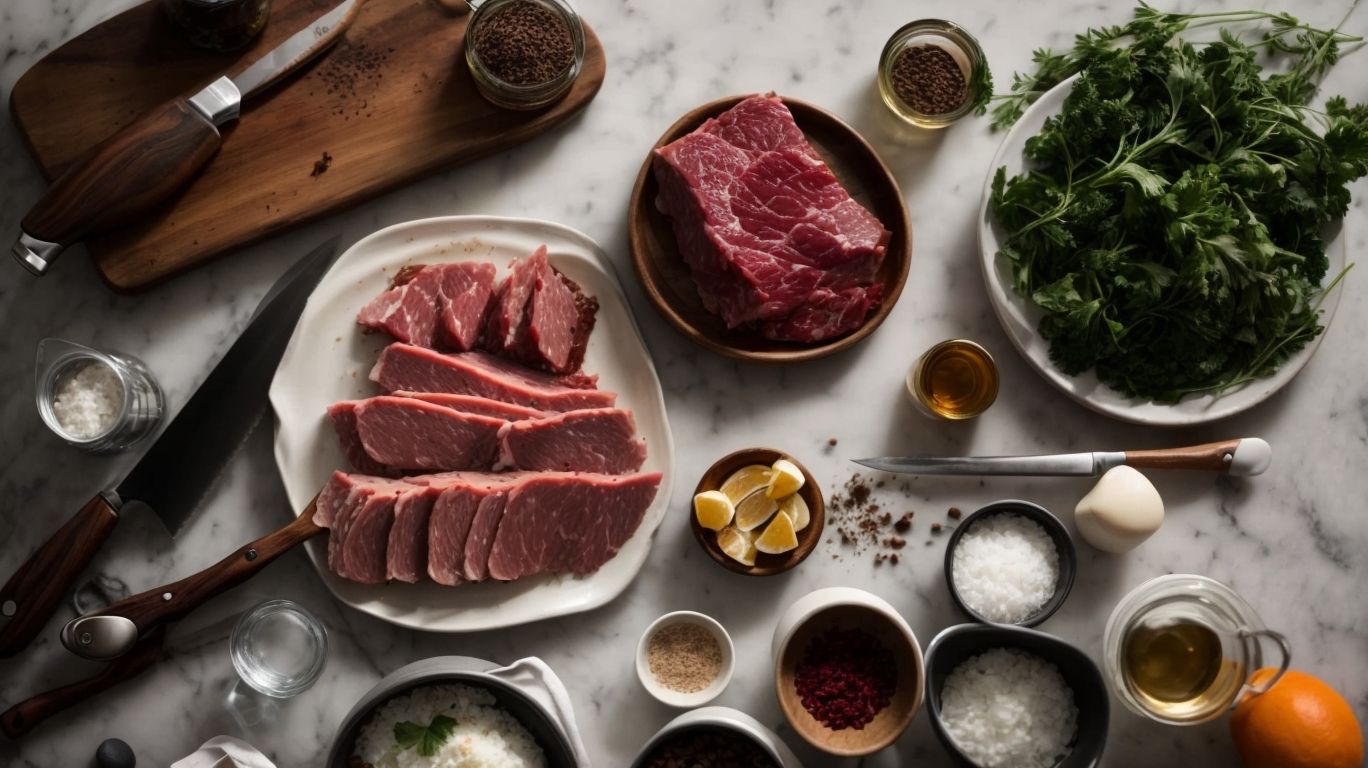
Credits: Poormet.Com – Bradley Nelson
Cooking a netted ham requires specific tools such as a meat thermometer, serving platter, and carving utensils to ensure proper cooking and presentation.
Aside from these essential tools, oven mitts are crucial for handling the hot ham safely. It is also helpful to have butchers twine to secure the netted ham during cooking.
When serving a delicious ham from Vermont or a specialty ham from Dakin Farm, having elegant serving forks and knife sets adds a touch of sophistication to the table setting.
For carving the ham with precision, a sharp carving knife and a dependable cutting board are critical. Utilizing a carving fork to hold the ham steady while slicing ensures neat and uniform cuts for a visually appealing presentation.
What Type of Pan is Best for Cooking a Netted Ham?
Selecting the right pan for cooking a netted ham is crucial to achieving even heat distribution and optimal roasting results.
When choosing a pan for your ham, consider materials such as stainless steel, cast iron, or aluminum, as they conduct heat efficiently. A stainless steel pan is versatile and easy to clean, while cast iron retains heat well and is great for searing before baking. Size is important too – make sure the pan can hold the ham comfortably without overcrowding. Ensuring proper heat conductivity is vital for cooking ham thoroughly and retaining its juices. Whether you’re basting with water or baking the ham, the right pan can make all the difference in flavor and texture.
What Other Tools Can Be Used for Cooking a Netted Ham?
Plus pans, several other tools can aid in the cooking process of a netted ham, enhancing efficiency and precision in the kitchen.
One essential tool for preparing a netted ham is a high-quality basting brush to evenly distribute flavorful glazes, marinades, or juices, ensuring a delicious outcome. Using twine for trussing can help maintain the shape of the ham during cooking, resulting in a beautifully presented dish that is sure to entertain guests. Investing in a durable roasting rack can elevate the ham above the drippings, allowing for optimal airflow and even cooking. These tools, when combined with careful planning and pre-cooking techniques, can simplify the entire cooking process and lead to a delectable ham centerpiece.
How to Prepare a Netted Ham for Cooking?
Preparing a netted ham for cooking involves steps such as thawing, scoring the ham, and adding flavorful elements for a delectable outcome.
Thawing the ham is a crucial step in the process. Make sure to allow enough time for it to defrost properly in the refrigerator.
- For scoring the ham, use a sharp knife to create shallow cuts in a crisscross pattern on the surface, which not only enhances presentation but also allows for better absorption of flavors.
In terms of infusing flavors, consider classic choices like cloves, garlic, and honey glaze. Eric, an experienced chef, suggests stud the scored areas with cloves and garlic, then brush the ham with a luscious honey glaze mixture to elevate its taste profile.
How to Thaw a Frozen Netted Ham?
Thawing a frozen netted ham requires proper planning and refrigeration to ensure safe and even thawing before the cooking process.
One of the most crucial factors to consider when thawing a frozen netted ham is to prevent the growth of harmful bacteria by keeping the moisture level controlled. The ideal method for defrosting a ham is placing it in the refrigerator, allowing for a slow and consistent thaw. Avoid thawing at room temperature, as this can lead to uneven thawing and potential contamination. Do not thaw your ham on the kitchen counter or in hot water, as this can create a breeding ground for bacteria.
How to Score the Ham?
Scoring the ham before cooking helps enhance flavor penetration and visual presentation, creating an appealing surface for glazes and seasonings.
One effective method to score a ham is to make cross-hatch cuts using a sharp knife, ensuring the cuts are not too deep. This technique not only allows the flavors from spices like cloves to infuse into the meat effectively but also helps in enhancing moisture retention during the cooking process.
Before roasting, you can marinate the scored ham in a mixture of water and seasonings to further optimize flavor absorption, resulting in a juicy and flavorful centerpiece for your meal.
How to Add Flavour to the Ham?
Infusing flavor into the ham can be done through a variety of methods, such as using glazes, marinades, or spice rubs to enhance taste and aroma.
- Glazing the ham with a mixture of honey, mustard, and brown sugar can add a sweet and sticky outer layer, balancing the savory richness of the meat.
- Marinating the ham in a blend of pineapple juice, soy sauce, and garlic can infuse tropical flavors and tenderize the meat for a juicy and flavorful result.
- Seasoning the ham with herbs like rosemary, thyme, and smoked paprika can create a herbaceous and smoky taste profile, elevating the overall taste experience.
How to Cook a Netted Ham?
Cooking a netted ham in the oven requires precise timing and temperature control to achieve a succulent and evenly cooked dish.
Preheat the oven to 350°F to ensure that the ham cooks thoroughly without drying out. Place the ham on a roasting rack in a shallow roasting pan, uncovered, to allow the heat to circulate evenly around the meat. For a delicious twist, consider making a mustard sauce glaze to enhance the flavors of the ham. To keep the ham moist, baste it every 30 minutes with the pan juices or glaze mixture. Cook the ham for approximately 15-20 minutes per pound, until an internal temperature of 145°F is reached.
What is the Recommended Cooking Time and Temperature?
Determining the optimal cooking time and temperature for a netted ham ensures that it reaches the desired level of doneness and flavor development.
In terms of the cooking process, a general rule of thumb for netted hams is to preheat the oven to 325°F. This moderate heat allows the ham to cook evenly without drying out. Depending on the weight of the ham, you can estimate a cooking time of around 15-20 minutes per pound. For accurate results, however, it is always recommended to use a meat thermometer to check the internal temperature.
How to Check If the Ham is Cooked?
Checking the doneness of a netted ham involves using a meat thermometer to verify internal temperatures and ensure that the meat is cooked through and safe to eat.
Another way to check the ham’s doneness is by paying attention to visual cues during the cooking process. The ham’s color should turn darker as it cooks, and the surface should caramelize if brown sugar or glaze is used. The meat should feel firm but slightly springy to the touch when done. However, the most accurate way to confirm if the ham is fully cooked is by using a meat thermometer.
When using a meat thermometer, you should insert it into the thickest part of the ham without touching the bone to get an accurate reading. Dakin Farm recommends cooking a netted ham to an internal temperature of 140°F (60°C) for optimal taste and safety. Make sure to follow safe cooking practices to prevent any foodborne illnesses and enjoy a delicious ham for your next gathering.
What to Do If the Ham is Not Cooked Yet?
If the netted ham is not fully cooked within the expected time frame, adjustments can be made by increasing the oven temperature or extending the cooking duration.
To ensure that your ham is cooked to perfection, start by preheating the oven to the suggested temperature. If you find that the ham is undercooked after the initial cooking time, you can increase the temperature by 25°F and continue cooking. It’s also helpful to periodically check the internal temperature of the ham with a meat thermometer.
If you notice the outer layer of the ham browning too quickly while the inside remains undercooked, you can cover the ham loosely with foil to prevent further browning, allowing the inside to cook through. Adding a small amount of water to the bottom of the roasting pan can create steam and aid in the cooking process.
How to Serve and Store a Cooked Netted Ham?
Serving and storing a cooked netted ham involves precise carving for presentation and proper storage methods for maintaining freshness and flavor.
When serving a netted ham, start by placing it on a cutting board and removing the decorative netting carefully to reveal the succulent meat beneath. Using a sharp knife, slice the ham against the grain for tender pieces. For a festive touch, arrange the slices on a platter garnished with mashed potatoes and colorful steamed vegetables. Leftovers should be stored in an airtight container in the refrigerator to keep them moist and delicious for future meals. To further enhance the flavors, consider using the leftover ham to make sandwiches or salads.
How to Slice the Ham for Serving?
Slicing a cooked netted ham requires skill and precision to create uniform portions for serving, enhancing the visual appeal of the dish.
When dealing with a roast ham enveloped in its netting, it’s crucial to carve properly to maintain the ham’s juiciness and flavor. Start by placing the ham on a cutting board with a steady hand. To achieve even slices, use a sharp knife and make clean, smooth cuts perpendicular to the bone.
Maple syrup is a popular glaze choice for ham, adding a touch of sweetness that complements the savory flavors. For serving, arrange the slices neatly on a platter, garnished with herbs or fruits for an elegant presentation.
How to Store Leftover Netted Ham?
Properly storing leftover netted ham is essential to maintain its quality and flavor for future consumption, ensuring minimal waste and maximum enjoyment.
When refrigerating cooked ham, it is crucial to properly wrap it to prevent drying out. Store the ham in an airtight container or wrap it tightly in aluminum foil or plastic wrap. This helps retain moisture and prevents the ham from absorbing other odors in the fridge. Make sure to place it on the bottom shelf to avoid any cross-contamination. If your ham came in a netting, leave it on during refrigeration to help maintain its shape and juiciness.
Frequently Asked Questions
What is the best way to cook a netted ham?
The best way to cook a netted ham is by roasting it in the oven. This ensures that the ham cooks evenly and retains its moisture.
Do I need to remove the netting before cooking the ham?
No, it is not necessary to remove the netting before cooking the ham. The netting helps to keep the ham in shape and prevents it from falling apart.
How long should I cook a netted ham in the oven?
The general rule for cooking a netted ham is 20 minutes per pound at 350 degrees Fahrenheit. However, it is always best to check the internal temperature of the ham with a meat thermometer to ensure it is fully cooked.
Can I cook a netted ham in a slow cooker?
Yes, you can cook a netted ham in a slow cooker. However, it is important to make sure that the ham fits comfortably in the slow cooker and that the lid can still close properly.
What is the best way to add flavor to a netted ham?
One of the best ways to add flavor to a netted ham is by glazing it. You can use a variety of glazes such as honey mustard, maple brown sugar, or even pineapple juice to add a delicious flavor to your ham.
How long should I let the ham rest before carving?
It is important to let the ham rest for about 10-15 minutes before carving to allow the juices to redistribute. This will ensure that your ham is juicy and tender when served.

